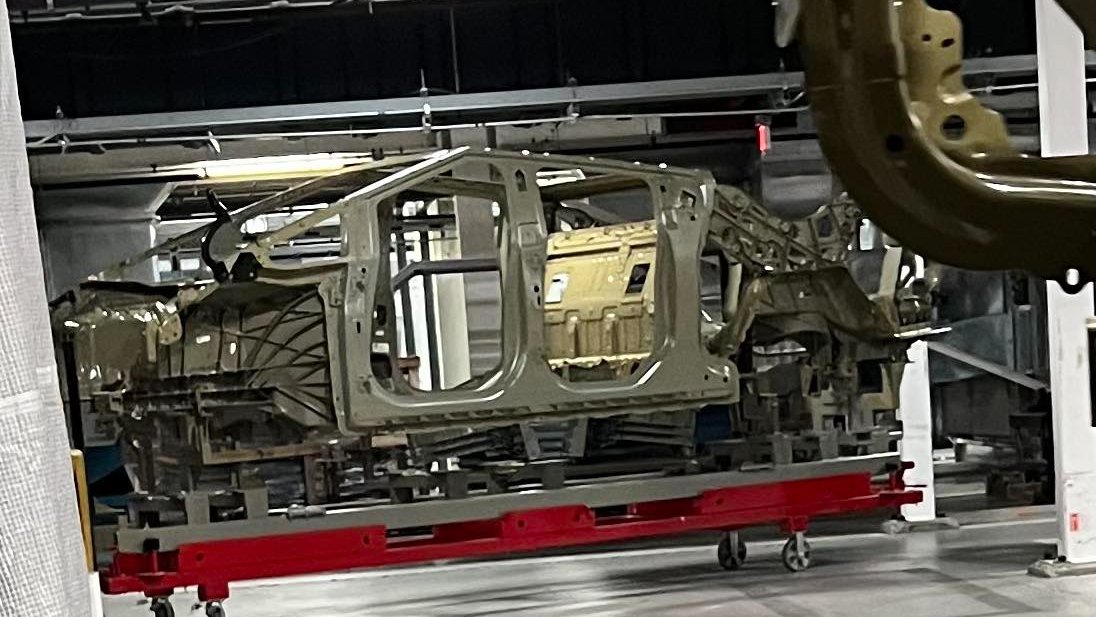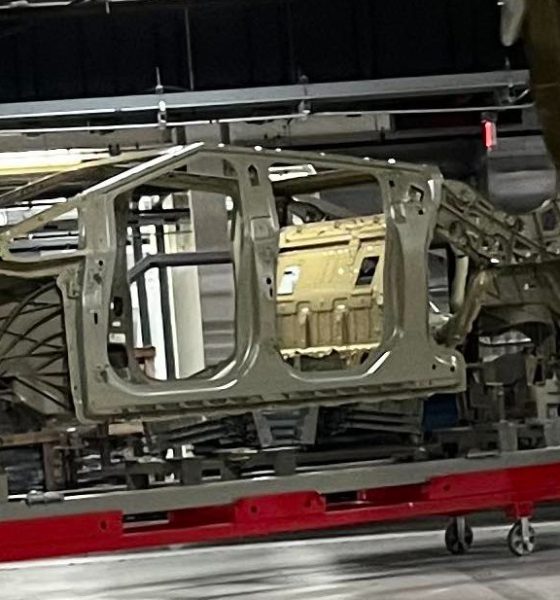

News
Leaked Tesla Cybertruck frame image shows disappointing design detail
A leaked Tesla Cybertruck frame image shows a disappointing design detail that many owners hoped to have, as there is no cargo tunnel into the vault that would extend the hauling length allowing for long materials to extend from the bed into the cabin.
A photo of the Cybertruck on production lines as the body comes together shows the vehicle is fitted with anti-corrosion coating, which is a great idea for the truck as it will be used commonly as a construction vehicle.
Tesla also plans to have the Cybertruck operate in water as a boat, at least in some instances, and the anti-corrosion is a great idea if owners put this to the test.
If they do, extensive damage can occur, and if it is too far gone, corrosion could be the death sentence for the all-electric pickup.
Separately, observers of the Cybertruck are interested in the lack of a passthrough from the bed to the cabin.
Those on the Tesla Motors subreddit are disappointed to see that there is no evident passthrough in the body of the Cybertruck that would link the cabin to the bed, which eliminates the possibility of using the pickup as an overlander for camping, or for excessive space for hauling materials.
Anti corrosion coating looking good on the CyberTruck! Here we see there will be no cargo tunnel into the vault. pic.twitter.com/cyuK0hxDz1
— ₮ƧLλ ₱H∅ΞN!X (@TeslaPhx) July 14, 2023
Speculation has persisted for some time on whether Tesla would include a passthrough for various applications. Of course, the final design of the Cybertruck has been seen on various occasions throughout Texas and California, but the finer details have yet to be revealed by Tesla.
Things like this design detail, in particular, are not likely to be revealed until the Cybertruck’s delivery event, which is scheduled for this quarter and will hopefully happen on time.
Tesla has been known to be aggressive with some timelines, but all evidence seems to show the Cybertruck’s initial production phases have started and the automaker is moving forward with the initial customer builds.
Tesla Cybertruck body with single-piece rear megacast spotted in Giga Texas
There are several reasons the Cybertruck may not have been the most ideal candidate for a passthrough, or midgate, as it is often called. Tesla will do things that they feel are best for the vehicle and its design, and that is our first conclusion: maybe they just didn’t want to do it.
Secondly, it could have been an engineering issue. Midgates would likely require a different build of the truck entirely, and although it is only a slight difference in design, Tesla may have had its mind set on developing the Cybertruck without one. More details could be revealed on why in the future, but it does not seem apparent at the moment.
There are no known safety issues with having a midgate, and if Tesla was hoping to win over some truck buyers with the Cybertruck, there is the possibility that the lack of one could have potential customers opting for another design. The Sierra EV Denali from GMC has one, as well as the Silverado EV from Chevrolet, but only in its most expensive configuration, which comes in over $100,000.
While we don’t expect it to be a major pain point for truck buyers that are opting for an EV, the Tesla Cybertruck lacking a midgate could be one of the few downsides of the pickup as initial deliveries near.
Cybertruck customers: Is the lack of a midgate going to be a pain point for you? If so, please email me at joey@teslarati.com. I’d love to chat! You can also reach me on Twitter @KlenderJoey, or if you have news tips, you can email us at tips@teslarati.com.

News
Tesla FSD fleet is nearing 7 billion total miles, including 2.5 billion city miles
As can be seen on Tesla’s official FSD webpage, vehicles equipped with the system have now navigated over 6.99 billion miles.

Tesla’s Full Self-Driving (Supervised) fleet is closing in on almost 7 billion total miles driven, as per data posted by the company on its official FSD webpage.
These figures hint at the massive scale of data fueling Tesla’s rapid FSD improvements, which have been quite notable as of late.
FSD mileage milestones
As can be seen on Tesla’s official FSD webpage, vehicles equipped with the system have now navigated over 6.99 billion miles. Tesla owner and avid FSD tester Whole Mars Catalog also shared a screenshot indicating that from the nearly 7 billion miles traveled by the FSD fleet, more than 2.5 billion miles were driven inside cities.
City miles are particularly valuable for complex urban scenarios like unprotected turns, pedestrian interactions, and traffic lights. This is also the difference-maker for FSD, as only complex solutions, such as Waymo’s self-driving taxis, operate similarly on inner-city streets. And even then, incidents such as the San Francisco blackouts have proven challenging for sensor-rich vehicles like Waymos.
Tesla’s data edge
Tesla has a number of advantages in the autonomous vehicle sector, one of which is the size of its fleet and the number of vehicles training FSD on real-world roads. Tesla’s nearly 7 billion FSD miles then allow the company to roll out updates that make its vehicles behave like they are being driven by experienced drivers, even if they are operating on their own.
So notable are Tesla’s improvements to FSD that NVIDIA Director of Robotics Jim Fan, after experiencing FSD v14, noted that the system is the first AI that passes what he described as a “Physical Turing Test.”
“Despite knowing exactly how robot learning works, I still find it magical watching the steering wheel turn by itself. First it feels surreal, next it becomes routine. Then, like the smartphone, taking it away actively hurts. This is how humanity gets rewired and glued to god-like technologies,” Fan wrote in a post on X.
News
Tesla starts showing how FSD will change lives in Europe
Local officials tested the system on narrow country roads and were impressed by FSD’s smooth, human-like driving, with some calling the service a game-changer for everyday life in areas that are far from urban centers.

Tesla has launched Europe’s first public shuttle service using Full Self-Driving (Supervised) in the rural Eifelkreis Bitburg-Prüm region of Germany, demonstrating how the technology can restore independence and mobility for people who struggle with limited transport options.
Local officials tested the system on narrow country roads and were impressed by FSD’s smooth, human-like driving, with some calling the service a game-changer for everyday life in areas that are far from urban centers.
Officials see real impact on rural residents
Arzfeld Mayor Johannes Kuhl and District Administrator Andreas Kruppert personally tested the Tesla shuttle service. This allowed them to see just how well FSD navigated winding lanes and rural roads confidently. Kruppert said, “Autonomous driving sounds like science fiction to many, but we simply see here that it works totally well in rural regions too.” Kuhl, for his part, also noted that FSD “feels like a very experienced driver.”
The pilot complements the area’s “Citizen Bus” program, which provides on-demand rides for elderly residents who can no longer drive themselves. Tesla Europe shared a video of a demonstration of the service, highlighting how FSD gives people their freedom back, even in places where public transport is not as prevalent.
What the Ministry for Economic Affairs and Transport says
Rhineland-Palatinate’s Minister Daniela Schmitt supported the project, praising the collaboration that made this “first of its kind in Europe” possible. As per the ministry, the rural rollout for the service shows FSD’s potential beyond major cities, and it delivers tangible benefits like grocery runs, doctor visits, and social connections for isolated residents.
“Reliable and flexible mobility is especially vital in rural areas. With the launch of a shuttle service using self-driving vehicles (FSD supervised) by Tesla in the Eifelkreis Bitburg-Prüm, an innovative pilot project is now getting underway that complements local community bus services. It is the first project of its kind in Europe.
“The result is a real gain for rural mobility: greater accessibility, more flexibility and tangible benefits for everyday life. A strong signal for innovation, cooperation and future-oriented mobility beyond urban centers,” the ministry wrote in a LinkedIn post.
News
Tesla China quietly posts Robotaxi-related job listing
Tesla China is currently seeking a Low Voltage Electrical Engineer to work on circuit board design for the company’s autonomous vehicles.

Tesla has posted a new job listing in Shanghai explicitly tied to its Robotaxi program, fueling speculation that the company is preparing to launch its dedicated autonomous ride-hailing service in China.
As noted in the listing, Tesla China is currently seeking a Low Voltage Electrical Engineer to work on circuit board design for the company’s autonomous vehicles.
Robotaxi-specific role
The listing, which was shared on social media platform X by industry watcher @tslaming, suggested that Tesla China is looking to fill the role urgently. The job listing itself specifically mentions that the person hired for the role will be working on the Low Voltage Hardware team, which would design the circuit boards that would serve as the nervous system of the Robotaxi.
Key tasks for the role, as indicated in the job listing, include collaboration with PCB layout, firmware, mechanical, program management, and validation teams, among other responsibilities. The role is based in Shanghai.
China Robotaxi launch
China represents a massive potential market for robotaxis, with its dense urban centers and supportive policies in select cities. Tesla has limited permission to roll out FSD in the country, though despite this, its vehicles have been hailed as among the best in the market when it comes to autonomous features. So far, at least, it appears that China supports Tesla’s FSD and Robotaxi rollout.
This was hinted at in November, when Tesla brought the Cybercab to the 8th China International Import Expo (CIIE) in Shanghai, marking the first time that the autonomous two-seater was brought to the Asia-Pacific region. The vehicle, despite not having a release date in China, received a significant amount of interest among the event’s attendees.








